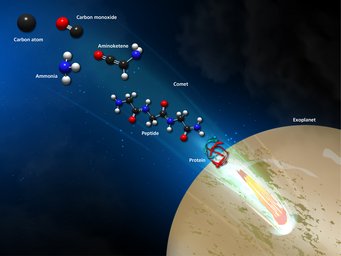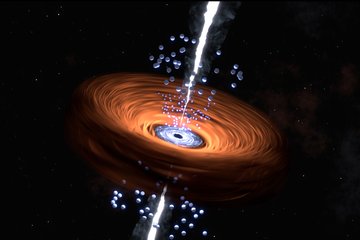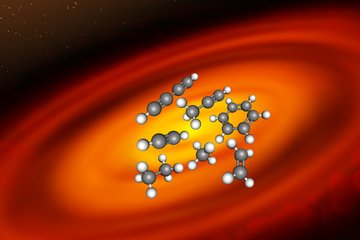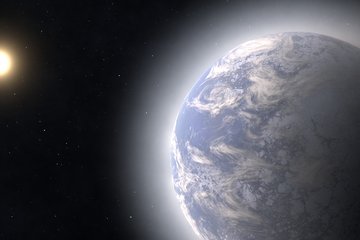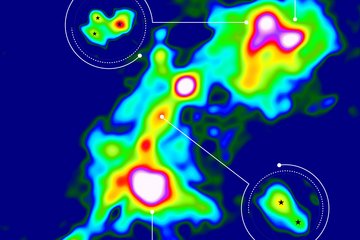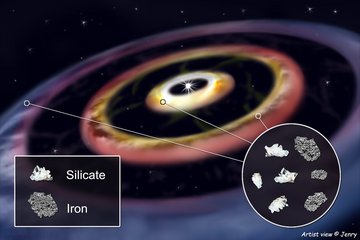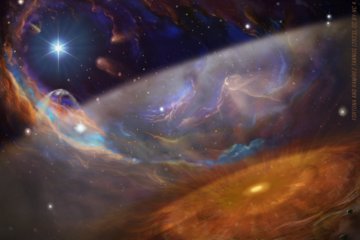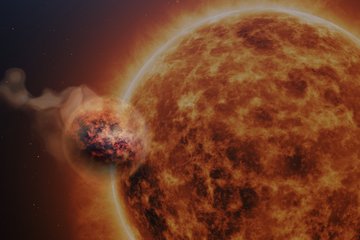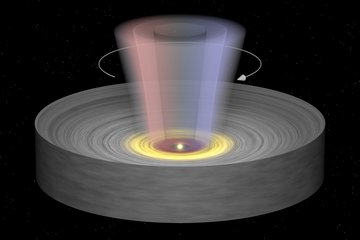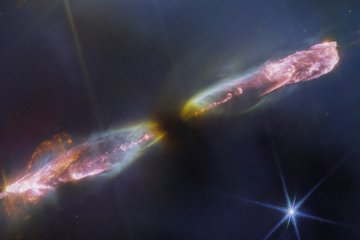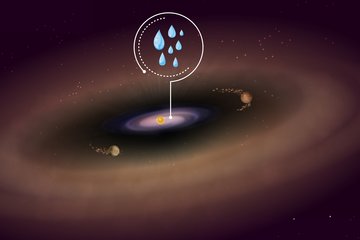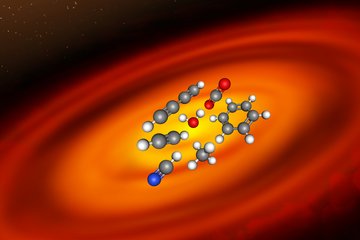Peptides in outer space: new chemical pathway allows for biomolecules to form on cosmic dust grains
Researchers from the University of Jena and the Max Planck Institute for Astronomy have demonstrated an unusual new form of chemical reaction that could allow some of the smallest biomolecules, namely peptides, to form on the icy surface of dust grains in outer space. Peptides are one of the basic building blocks of life, and the new discovery bolsters scenarios in which complex organic molecules, having formed on dust grains in molecular clouds in outer space and having been carried to Earth by meteoroids, asteroids or comets, could help kick-start the emergence of life on Earth. The new results have now been published in Nature Astronomy.
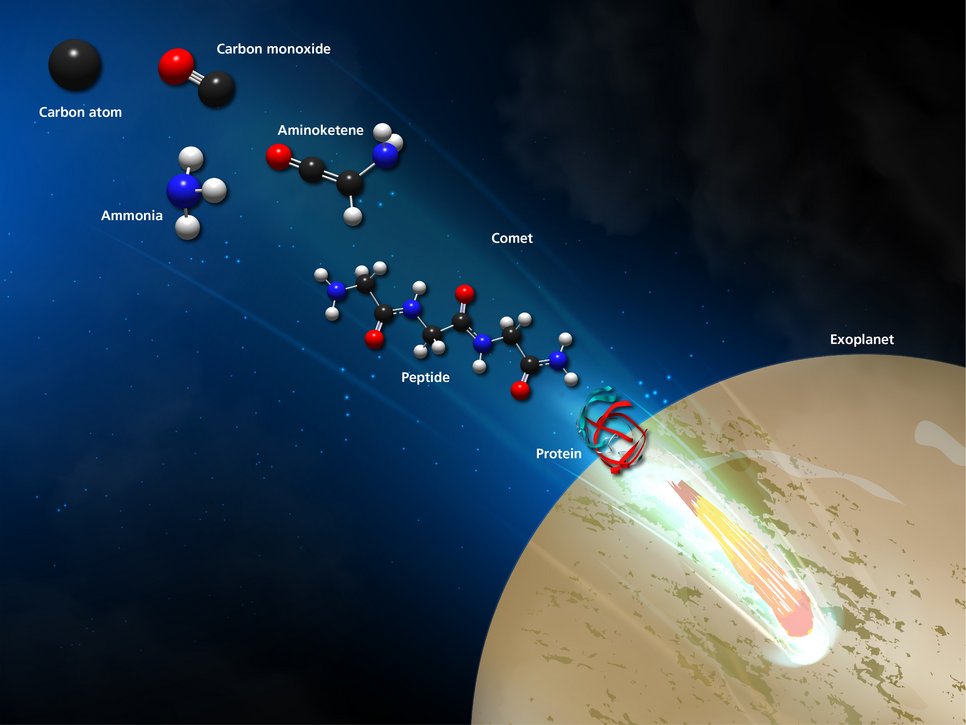
The origin of life on Earth might have a cosmic as well as a terrestrial component: organic molecules that have formed in space, carried to Earth by meteorites, could have provided basic pre-biological building blocks for the emergence of life proper, that is, of self-replicating entities such as proto-cells. Scenarios of this kind provide an interesting alternative to an Earth-only scenario that has the necessary organic chemicals for the emergence of life form directly on Earth. A few years ago, astronomers from McMaster University in Canada and from MPIA presented a calculation for scenarios where this kind of "cosmic seeding" transformed warm, shallow ponds on Earth into suitable locations for the emergence of life.
But it is still an open question how complex the cosmic organic molecules might become – and hence what help they might have provided for the origin of life. The new results presented here add an important new kind of molecule to the repertoire of space-borne organic molecules: peptides, the shorter cousins of proteins. Peptides play a number of important roles in living organisms – and the newly discovered pathway shows how these molecules may form in large numbers in the depths of outer space.
Ice-covered dust grains as cosmic laboratories
Thomas Henning, co-author of the new study and director at the Max Planck Institute for Astronomy, says: "It is an amazing fact that complex organic molecules exist in denser regions between the stars, in protoplanetary disks, primitive meteorites and comets. They can be formed by a variety of processes from processes in the gas phase, on icy grain surfaces and wet chemistry on the parent bodies of meteorites."
For the present results, the icy surfaces of dust grains are particularly relevant. Such grains are produced in the outer layers of cool stars and in the aftermath of supernova explosions, but more recent research has shown indications that most of the dust in galaxies is formed directly within the interstellar medium – the regions in the vast spaces between the stars, which contain low-density matter as well as radiation. The dust consists of carbon or silicate atoms, clumped together into conglomerates less than one millionth of a meter in diameter. If we disregard hydrogen and helium, dust accounts for about half of the mass of the remaining matter in the giant molecular clouds that form part of the interstellar medium. Those giant molecular clouds are important as the locations where new stars are born – and some of the dust will be the basis for forming new planets.
The key to the cosmic chemistry of dust grains are ice layers forming around the dust grains, as molecular water and carbon monoxide, but also other molecules accrete ("get stuck") on the grain surface. Those ice layers can serve as a cosmic chemistry lab: as a substrate on which molecules can collect, and come close enough to each other for chemical reactions to take place.
How complex can space molecules get?
So how complex can molecules get, under those conditions – on the icy surface of dust grains in giant molecular clouds? The answer to that question may well be important for the emergence of life on Earth. That, after all, determines what cosmic molecules meteorites or larger bodies could deliver to Earth's surface.
As the new results that have just been published in Nature Astronomy show, molecules forming on icy dust-grain surfaces can become more complex than previously thought! More specifically: Under realistic conditions, the conditions on such icy surfaces can lead to the formation of peptides. Peptides play important roles in the physiology of living organisms here on Earth. Furthermore, they are very short versions of the proteins that, in turn, play a central role for life as we know it.
C atoms
For the study's lead author Serge Krasnokutski (University of Jena and research group "Laboratory Astrophysics" of the Max Planck Institute for Astronomy), the result is the latest waypoint in a long research journey centered on the role of single, unbound carbon atoms, "C atoms" in the low-temperature chemistry in molecular clouds and in the disks of gas and dusts surrounding young stars.
When Krasnokutski initially became interested in C atoms, there was not even a suitable way of including such atoms in the experiments used to simulate the conditions on interstellar dust grains. So he developed a technique for producing low-energy C atoms suitable for low-temperature experiments. By 2014, that technique was patented, shortly afterwards it became available commercially, and it has since been used in a number of laboratories world-wide.
The problems of adding and removing water
Krasnokutski pushed forward both with low-temperature chemistry experiments using his new technique and with theoretical calculations. In 2020, together with the MPIA Laboratory Astrophysics leader Cornelia Jäger and MPIA director Thomas Henning, he published proposal, backed up by experimental data, for how glycine, the simplest amino acid (which plays an important role in all of life on Earth) could form with the help of such C atoms on cosmic dust grains – even without the need for ultraviolet photons to provide energy for the chemical reactions in question.
Krasnokutski became convinced that C atoms had a key role to play in low-temperature chemistry under outer-space conditions. He says: "Single carbon atoms are surprisingly reactive, even at the lowest temperatures. They act as 'molecular glue' that joins molecules together, and turns inorganic substances into organic ones."
It was natural to consider the next step in basic molecular biology: the step where amino acids form chain-like molecules – peptides or proteins. When this process happens in modern living organisms, it is rather involved: For the chain to form (the process of "polymerization"), water molecules need to be detached from the amino acids. That takes energy, and thus requires a certain minimum temperature, much higher than the temperature of cosmic ice grains. Curiously, in the low-temperature formation of the amino acid glycine, the problem had been the opposite: under low-temperature conditions on a cosmic dust grain, it was difficult to form glycine because it required the attachment of a water molecule.
Why not skip the water part altogether?
But if the attachment of a water molecule to make an amino acid, and later the water molecule's removal in order to form peptides or proteins, are both problematic, Krasnokutski thought, why take this detour in the first place? With carbon present in the shape not only in the bound form of carbon monoxide, but as single C atoms, was there perhaps a more direct way to get to peptides (and, by implication, the longer proteins)?
With the help of quantum-chemical calculations, Krasnokutski was able to identify a likely first step of such a direct pathway: Under the conditions found on small icy surfaces, the reaction transforming carbon monoxide, C atoms, and ammonia into aminoketene, a molecule that is just one water molecule short of the amino acid glycine, indeed seemed to occur spontaneously, requiring no additional energy input.
Simulating cosmic dust grains
The formation of aminoketene, in turn, was a promising step towards forming the simplest form of peptides: glycine peptides. But there was no way of simply calculating what would come next, and whether the aminoketene would indeed transform itself into the polymer chains needed to make a peptide. These questions would need to be answered by experiment.
The researchers used a sophisticated experimental setup that is able to reproduce the key properties of an icy dust-grain surface in space: The INter-Stellar Ice Dust Experiment (INSIDE) that had been developed a few years previously at MPIA's Laboratory Astrophysics Group at the University of Jena, led by Cornelia Jäger. The key element of the setup is an Ultra-High Vacuum (UHV) chamber, which provides vacuum as found in molecular clouds in the interstellar medium.
Infrared spectral fingerprints
In the version used for these experiments, the dust grain surface was simulated by a potassium bromide disk, 2 mm thick and 2.5 centimeters in diameter, whose temperature can be regulated very precisely, and down to a few degrees above absolute zero. Atoms and molecules can be deposited onto those surfaces, recreating the conditions one would expect to be found on the surfaces of cosmic dust grains.
Using an infrared (FTIR) spectrograph, which shines light onto the sample and analyses those portions of the light that come out on the other side (and thus have been neither absorbed nor scattered by the sample), it is possible to identify specific molecules, or parts of such molecules, on the simulated surface by their "spectral fingerprints": by the light they absorb or scatter at very specific wavelengths.
Making (and detecting) aminoketene
In their experiments, the researchers deposited a small amount of carbon monoxide, C atoms and ammonia – a layer that was at most a few dozen molecules or atoms thick. They cooled the substrate down to 10 Kelvin (as the typical temperature inside molecular clouds), and then collected different puzzle pieces: Does the reaction take place if only two of the three ingredients are present? (No.) What does the infrared spectroscopy show? A fingerprint that indicated the presence of aminoketene.
To clinch their case, the researchers carefully monitored what happened to their sample when they slowly warmed it up back to room temperature, and confirmed by mass spectroscopy (a very precise way of determining the masses of molecules or atoms) that the residue indeed contained the expected amounts of molecules with just the right mass. Evidently, aminoketene was indeed being formed on their dust-grain-substitute.
To make peptides, just do not add (or remove) water
The warming-up served another important purpose. At temperatures around 110 Kelvin, the substance deposited on the artificial cosmic dust grain began to change. The infrared spectroscopy showed tell-tale signs ("peptide bands" in the spectrum) associated with the presence of a type of chemical bond that keeps amino acids together in the shorter molecular chains ("polymers") of peptides, as well as the longer chains of proteins.
For interstellar dust grains, there are several ways that this slight warming-up could come about. Notably, the dust cloud would be warmed up when a new star is forming. It is also possible that those reactions would only occur once the dust grain has fallen onto a planetary surface – a planet inside the so-called habitable zone of its star can have surface temperatures that allow for liquid water. Together, the low-temperature chemistry forming aminoketene and the warming-up letting the aminoketene molecules bond to form peptide could create peptides on interstellar dust grains.
A new, cosmic pathway
Taking everything together, Krasnokutski and his colleagues had found a completely new chemical path to peptides and proteins that had never been considered before. Crucially, this path skips the stage of amino acid formation, and thus also the energy-intensive process of removing water in order to make amino acids come together to form peptides or proteins. The ingredients that are needed (C atoms, carbon monoxide, ammonia) are among the most abundant molecule species present in the interstellar medium. With the energy requirement removed, the alternative way of forming peptides, and more generally proteins, could lead to a considerable amount of that kind of organic material in space.
Krasnokutski says: "The single carbon atoms initiate a rich and diverse chemistry. Even under the conditions found in outer space, that chemistry goes much further towards what is needed for the emergence of life than previously thought."
Next steps
The new pathway to low-temperature peptide formation opens up a number of directions for further research. A few years ago, Thomas Henning and Serge Krasnokutski had developed a method that allows low-temperature chemical reaction to take place within droplets of liquid helium – making the peptide-forming pathway work in that setting would allow for a more precise analysis of each step of the reaction.
Furthermore, glycine peptides are only one of a variety of peptides important for life on Earth. But the reaction where the aminoketene molecules combine to form the chain structure of the peptide should be rather flexible – if other molecules are present when the reaction occurs, different peptides should be produced. Testing this hypothesis experimentally will be one of the ways that Krasnokutski and his colleagues will seek to extend their work.
More generally, the new results are part of a wider research program centered on the Max Planck Institute for Astronomy, which links up astronomy, chemistry and molecular biology in search of interdisciplinary answers in the search for the origin of life on Earth. Recent results from that programme include work by Oliver Trapp (LMU Munich, and associated with MPIA as a Max Planck Fellow) that examines a different way of forming peptide bonds as a step towards the origin of life – in that case, in an environment with liquid sulphur dioxide instead of the more classical water.
Background information
The results described here have been published as S. Krasnokutski et al., "A pathway to peptides in space through the condensation of atomic carbon", in the journal Nature Astronomy.
The MPIA researchers involved are Serge Krasnokutski (also University of Jena), Ko-Ju Chuang (also University of Jena, now at Leiden University), Cornelia Jäger (also University of Jena) and Thomas Henning, in collaboration with Nico Ueberschaar (University of Jena).
Krasnokutski, Chuang and Jäger are affiliated with MPIA via the laboratory astrophysics facility that MPIA operates at the Institute for Solid State Physics of the University of Jena, and which is headed by Cornelia Jäger. Chuang has since moved on to a professorship in Leiden. The Laboratory Astrophysics Group studies the condensation, irradiation-induced processing, and spectral properties of cosmic dust grains, as well as astrochemical reactions in molecular ice layers on dust grains that lead to the formation of complex organic and prebiotic molecules. Laboratory astrophysics is an interdisciplinary field whose research profits from the sophisticated experimental facilities that are available as a result of that collaboration.
Journalists who require access to the journal article (in particular before the lifting of the embargo) should please contact press@nature.com
